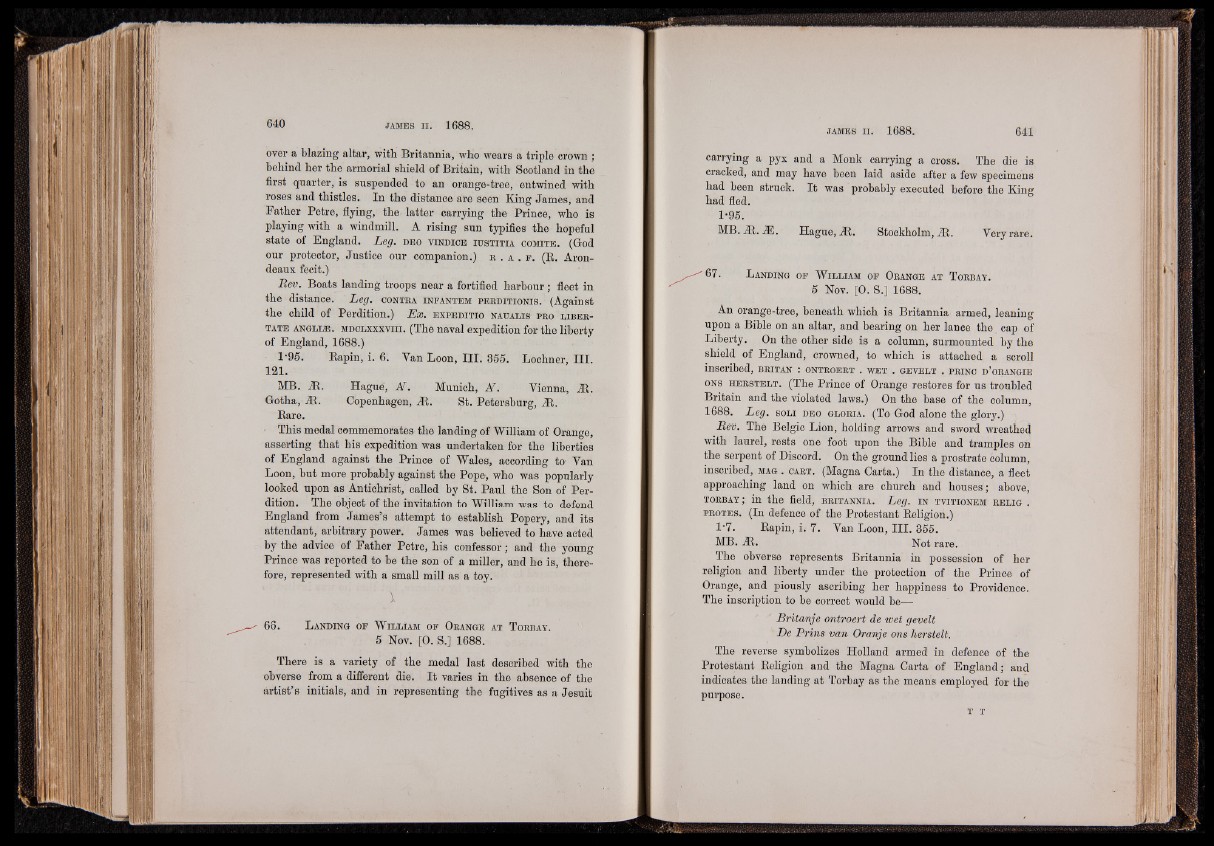
over a blazing altar, with Britannia, who wears a triple crown ;
behind her the armorial shield of Britain, with Scotland in the
first quarter, is suspended to an orange-tree, entwined with
roses and thistles. In the distance are seen King James, and
Father Petre, flying, the latter carrying the Prince, who is
playing with a windmill. A rising sun typifies the hopeful
state of England. Leg. d eo v in d ic e iu s t it ia c o m it e . (God
our protector, Justice our companion.) e . a . f . (R . Aron-
deaux fecit.)
Rev. Boats landing troops near a fortified harbour; fleet in
the distance. Leg. cont ea in f a n t em p e e d it io n is . (Against
the child of Perdition.) Ex. e x p e d it io n a u a l is p e o l ib e b -
t a t e a n g l i® . MDCLXXXvni. (The naval expedition for the liberty
of England, 1688.)
1'95. Rapin, i. 6. Van Loon, III. 355. Lochner, III.
121.
MB. 5 t. Hague, N . Munich, N . Vienna, 51.
Gotha, 51. Copenhagen, 51. St. Petersburg, 51.
Rare.
This medal commemorates the landing of William of Orange,
asserting that his expedition was undertaken for the liberties
of England against the Prince of Wales, according to Van
Loon, but more probably against the Pope, who was popularly
looked upon as Antichrist, called by St. Paul the Son of Perdition.
The object of the invitation to William was to defend
England from James’s attempt to establish Popery, and its
attendant, arbitrary power. James was believed to have acted
by the advice of Father Petre, his confessor; and the young
Prince was reported to be the son of a miller, and he is, therefore,
represented with a small mill as a toy.
’ ■ 11
68. L a n d in g o f W il l ia m o f Oea n g e at T oeb a y .
5 Nov. [0. S.] 1688.
There is a variety of the medal last described with the
obverse from a different die. I t varies in the absence of the
artist’s initials, and in representing the fugitives as a Jesuit
carrying a pyx and a Monk carrying a cross. The die is
cracked, and may have been laid aside after a few specimens
had been struck. I t was probably executed before the King
had fled.
1-95.
MB. 51.51. Hague, 5 t. Stockholm, 5 t. Very rare.
'67. L a n d in g o f W il l ia m o f Oea n g e at T oeba y .
5 Nov. [0. S.] 1688.
An orange-tree, beneath which is Britannia armed, leaning
upon a Bible on an altar, and bearing on her lance the cap of
Liberty. On the other side is a column, surmounted by the
shield of England, crowned, to which is attached a scroll
inscribed, b e it a n : o n t e o e e t . w e t . g e v e l t . p e in c d ’o ea n g ie
ons h e e s t e l t . (The Prince of Orange restores for us troubled
Britain and the violated laws.) On the base of the column,
1688. Leg. s o l i d e o g l o e i a . (To God alone the glory.)
Rev. The Belgic Lion, holding arrows and sword wreathed
with laurel, rests one foot upon the Bible and tramples on
the serpent of Discord. On the ground lies a prostrate column,
inscribed, mag . c a e t . (Magna Carta.) In the distance, a fleet
approaching land on which are church and houses; above,
toebay ; in the field, b e it a n n ia . Leg. in tv it io n em e e l ig .
p e o t e s . (In defence of the Protestant Religion.)
1*7. Rapin, i. 7. Van Loon, III. 355.
MB. 5 t. Not rare.
The obverse represents Britannia in possession of her
religion and liberty under the protection of the Prince of
Orange, and piously ascribing her happiness to Providence.
The inscription to be correct would be—
Britanje ontroert de wet gevelt
De Prins van Orange ons herstelt.
The reverse symbolizes Holland armed in defence of the
Protestant Religion and the Magna Carta of England; and
indicates the landing at Torbay as the means employed for the
purpose.